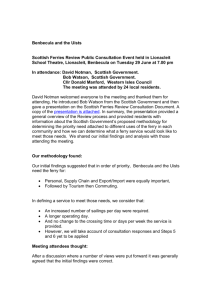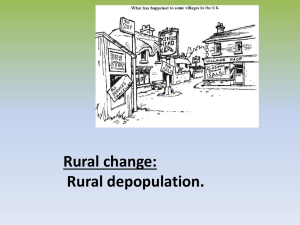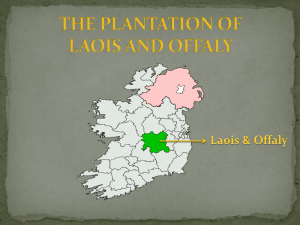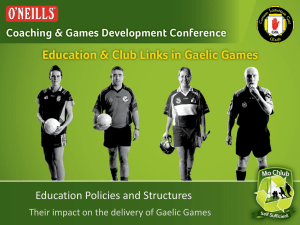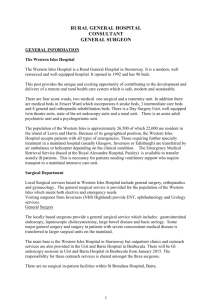benbecula medical practice
advertisement
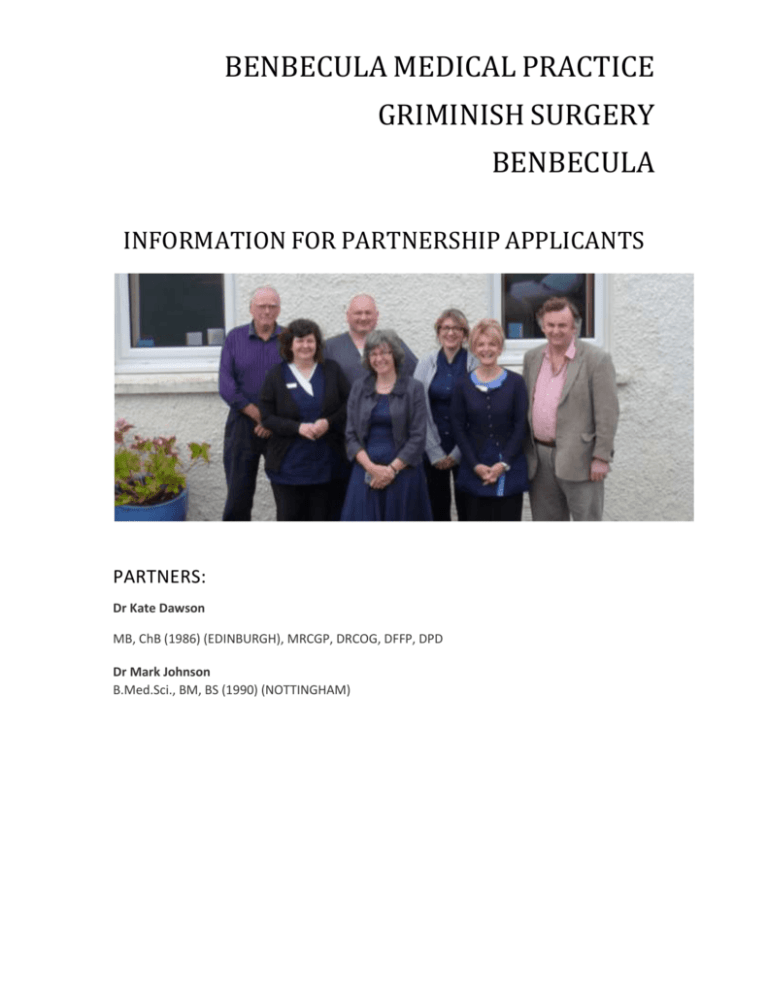
BENBECULA MEDICAL PRACTICE GRIMINISH SURGERY BENBECULA INFORMATION FOR PARTNERSHIP APPLICANTS PARTNERS: Dr Kate Dawson MB, ChB (1986) (EDINBURGH), MRCGP, DRCOG, DFFP, DPD Dr Mark Johnson B.Med.Sci., BM, BS (1990) (NOTTINGHAM) BENBECULA MEDICAL PRACTICE GRIMINISH SURGERY BENBECULA CONTENTS PARTNERS: ...................................................................................................................................................... 1 BENBECULA MEDICAL PRACTICE: ................................................................................................................... 3 UIST AND BARRA HOSPITAL:........................................................................................................................... 5 WESTERN ISLES HEALTH BOARD: ................................................................................................................... 7 LOCAL HOSPITALS: ...................................................................................................................................... 7 THE UISTS AND BENBECULA: .......................................................................................................................... 8 BENBECULA: ............................................................................................................................................... 8 SOUTH UIST: ............................................................................................................................................... 9 ECONOMY: .................................................................................................................................................. 9 CLIMATE: .................................................................................................................................................. 10 MISSILE TESTING:...................................................................................................................................... 11 COMMUNITY BUY-OUT: ........................................................................................................................... 11 HISTORY & ARCHAEOLOGY: ...................................................................................................................... 11 RECREATION: ............................................................................................................................................ 12 SCHOOLS & EDUCATION: .......................................................................................................................... 12 HOUSING: ................................................................................................................................................. 13 THE NATURAL ENVIRONMENT: ................................................................................................................ 13 TRAVEL AND COMMUNICATION: ............................................................................................................. 14 CULTURAL HERITAGE & THE GAELIC LANGUAGE: .................................................................................... 14 RELIGEON: ................................................................................................................................................ 15 Page 2 of 15 Drafted 06/09/2014 SKD BENBECULA MEDICAL PRACTICE GRIMINISH SURGERY BENBECULA BENBECULA MEDICAL PRACTICE: Benbecula Medical Practice is a remote and rural island practice in the Outer Hebrides, off the West Coast of Scotland. We are a four partner practice with regular locum support, looking after 2,350 patients. We are a dispensing practice, covering the island of Benbecula and part of the neighbouring island of South Uist. Dr Tierney joined the practice in 1991, Dr Senior in 1994, Dr Dawson in 1995 and Dr Johnson in 2000. Dr Senior retired at the end of 2014, and Dr Tierney retired in June 2015. We have a partner-elect who is hoping to start at the beginning of 2016. The practice employs a full-time practice manager, two full-time administrators/secretaries, two full-time and one part-time nurses, a clinical support worker, two part-time dispensers and a cleaner. All staff have a say in the running and planning of practice services. The nurses manage all chronic disease clinics. The GPs run surgeries every weekday morning. We also have afternoon surgeries on Mondays, Wednesdays and Fridays. We use a full appointment system with 10 minute appointments. Emergency appointments are available for same day appointments. Patients may also book appointments with nursing staff. The branch surgery in Daliburgh is open on Mondays and Thursdays from 9am to 5pm, with GP consulting from 9:30 to 11am. The midwifery team undertake all routine antenatal care, with patients being referred on to the GP for additional advice. Child health and immunisation clinics are held each week with the health visitor. Contraceptive and sexual health advice is available within normal surgery sessions. The main premises in Griminish are purpose built and were extended in 1992. They are rented from the Health Board. They consist of two consulting rooms, two treatment rooms, a dispensary, three offices, a staff room, reception and waiting area. The branch surgery, in Daliburgh, consists of two consulting rooms, a staff room, a reception/dispensary and a waiting area. In the past, the practice was a training practice, but the current accommodation is no longer sufficient. We provide placements for medical students from Dundee and St Andrew’s universities. We also support local school pupils who wish to apply to medical school, with high levels of success. If our accommodation issues could be resolved, and any future partners would wish, we would be able to consider becoming a training practice again. The practice has been fully computerised for many years, using EMIS since 1996. Incoming mail and documents are managed using docman. We plan to move over to digital dictation within the next few weeks. We are also part of a project to digitalise near-patient testing results. In the last year, the health board has started using ‘Jabber’ as an encrypted computer-based VC access, similar to Skype. This is enabling GPs in the islands better access to meetings, and educational events, and is also allows patients to access consultations remotely. The community team includes three district nursing teams, health visiting and school nurse service, two community psychiatric nurses, two MacMillan nurses, a heart failure liaison nurse, diabetic specialist Page 3 of 15 Drafted 06/09/2014 SKD BENBECULA MEDICAL PRACTICE GRIMINISH SURGERY BENBECULA nurse, etcetera. Most of the community health team are based several miles away near the community hospital. Our premises do not fully meet the current needs of the practice, and are hard to access by patients. It is a long-term aim of the practice to move to Balivanich, next to the community hospital, to form part of a hub of clinical services which will see the co-location of a number of health and social care services. We have a regular local programme of clinical learning and teaching, co-ordinated by one of the partners. Topics are generally selected on local relevance, recent advances and new guidelines, and alternate between local speakers and visiting consultants. The practice has recently supported the formation of a Patient Participation Group, which meets in Balivanich. They have set up a Facebook page and aim to enable patients and the surgery to work together to improve services and to promote health and improved quality of care. The practice is one of two that opted out of providing Out of Hours cover at the start of the current contract in 2004. The two practices initially contracted back with the health board and managed the oncall rota, sharing the workload. Over the last few years, the GPs from the practice to the North have pulled out of the rota. At present, we are in the process of passing the responsibility of managing the Out of Hours to the primary care manager in the Health Board, whilst continuing to provide some out-of-hours cover. We also provide custodial and basic forensic support to the local police service, as well as responding to ambulance ‘dual response’ requests. The practice also provides primary care services to RAF personnel at the local military base. There is also a military medical centre on St. Kilda, to which we provide telephone support to the duty nurse. These additional roles are supported by extended training in emergency medicine, pre-hospital care, online forensic training etcetera, supported by the NHSWI. Because of our remote location, we provide a very full range of services within the practice, often taking on community-based extended management to help patients avoid arduous trips to the mainland. In 2013, the practice opposed the establishment of a dispensing pharmacy in the area; this would have substantially undermined our business. We were successful not only in proving our case, but also instrumental in supporting the health board in a new pilot to develop new models of providing pharmaceutical support in remote and rural dispensing practices. The practice has a good working relationship with the practices in the area, and in particular, the practices in Barra, South Uist and North Uist. We organise joint educational opportunities, and occasionally socialise together when the opportunity presents. http://www.benbeculamedicalpractice.co.uk/ https://www.facebook.com/groups/BMPPPG/ Page 4 of 15 Drafted 06/09/2014 SKD BENBECULA MEDICAL PRACTICE GRIMINISH SURGERY BENBECULA UIST AND BARRA HOSPITAL: Ospadal Uibhist agus Bharraigh (Uist and Barra Hospital) is located in Benbecula, and was officially opened in 2001. It provides a local service for the populations on Benbecula, North Uist, South Uist and associated islands. The hospital currently has 27 beds, and provides care of the elderly, GP Acute and Midwifery led maternity services. Many of the Consultants from the Western Isles Hospital, and some from mainland Health Boards, visit the Uist and Barra Hospital to provide outpatient services. The hospital is the only source of in-patient and emergency medical care locally; because of our location, we are the first point of call for all and any clinical condition from ingrown toenails to acute ischaemic heart disease and road traffic accidents. We are also central to the management of major incidents and as a result the practice has input into local emergency planning. We are supported by consultants in Stornoway by telephone, and by the Ambulance and Air ambulance services and by the Emergency Retrieval Service. The health board intranet also provides a range of policies, guidelines and treatment pathways to support our in-patient clinical work. Medical cover and clinical leadership for the hospital are provided under a Local Enhanced Service agreement with Benbecula Medical Practice. At present the services provided by the hospital are being under review; a new hospital service plan is about to be developed as a requirement of ‘Community Strategy Refresh’ which is part of the Scottish NHS 20:20 vision. Our practice provides medical cover for all emergencies and admissions. Patients with serious conditions can be stabilised before onward transfer, either by air ambulance, or retrieved by the Emergency Medical Retrieval Service, who provide in-flight medical support, and are able to intubate and ventilate patients prior to transfer. Page 5 of 15 Drafted 06/09/2014 SKD BENBECULA MEDICAL PRACTICE GRIMINISH SURGERY BENBECULA Visiting consultants from Stornoway and Inverness hold outpatient clinics at the hospital. This includes general medical, surgical, community paediatrics, psychiatry, obstetrics and gynaecology, ENT and ophthalmology. Two local GPs also undertake clinics for respiratory medicine and dermatology as Hospital Practitioners. Until now, the GP surgeon based in Benbecula Medical Practice has undertaken regular surgical clinics, minor surgery lists and the local endoscopy service. The health board is currently looking at continuing these services with consultants visiting from Stornoway. The community hospital recently achieved a very good report from Health Improvement Scotland; this was achieved due to great team work and support from the Western Isles Infection Control team. http://www.healthcareimprovementscotland.org/our_work/inspecting_and_regulating_care/hei_wester n_isles_reports/uist_and_barra_aug_14.aspx http://www.emrs.scot.nhs.uk/ http://www.snprs.scot.nhs.uk/ Page 6 of 15 Drafted 06/09/2014 SKD BENBECULA MEDICAL PRACTICE GRIMINISH SURGERY BENBECULA WESTERN ISLES HEALTH BOARD: NHS Western Isles (NHSWI) is the organisation responsible for providing healthcare to the population of the Western Isles, which is made up of approximately 26,500 people. The board employs over 1,000 staff. NHSWI works alongside mainland Health Boards, the local authority (CnES) and third sector organisation to provide services to the local population. Where possible, services are provided in the Western Isles, but for specific procedures and more specialist services, patients travel to the mainland, usually to hospitals in Glasgow or Inverness. NHSWI and the local authority (CnES) have just agreed their model for progressing a statutory program of Health and Social Care Integration, opting for a joint board model. This will lead to opportunities in the future for commissioning new services. There are nine different GP Practices in the Western Isles working from 14 sites. NHSWI has a number of statutory committees, including the GPSub, Local Medical Committee, Area Medical Committee, Area Drugs and Therapeutics Committee etcetera. The practice actively supports these committees; at present, one of the partners (Dr Dawson) chairs the GPSub/LMC and AMC, and is a member of the Area Clinical Forum. LOCAL HOSPITALS: There are three hospitals run by NHS Western Isles. The largest is the Western Isles Hospital, a Rural General Hospital located in Stornoway. The Western Isles Hospital was opened in 1992 with a range of hospital acute specialities, psychiatry and care of the elderly. The hospital also includes diagnostic facilities, day hospital, laboratory, Allied Health Professionals and other services. Ospadal Uibhist agus Bharraigh (Uist and Barra Hospital) is located in Benbecula, and was opened in 2001. St Brendan’s Hospital, with 5 beds, is located in Castlebay on the Isle of Barra and is in a shared building with a local authority care home facility. It is supported by the local GP Practice to provide care of the elderly and other services. It is currently being redeveloped. http://www.wihb.scot.nhs.uk/ https://twitter.com/NHSWI https://www.facebook.com/NHSWesternIsles?ref=hl Page 7 of 15 Drafted 06/09/2014 SKD BENBECULA MEDICAL PRACTICE GRIMINISH SURGERY BENBECULA THE UISTS AND BENBECULA: Island of Benbecula The Uists and Benbecula form part of the Western Isles. The islands are located 40 miles off the North West coast of Scotland, 130 miles long from the Butt of Lewis in the North to the Isle of Barra in the South. The population of the Western Isles is approximately 26,500, spread over 280 townships. Around 22% of the population are over 65, proportionately one of the most elderly populations in Scotland. The islands are one of the last remaining strongholds of the Gaelic language in Scotland. In 2006, the islands of South Uist, Eriskay and a large part of Benbecula were involved in Scotland’s biggest community buy-out. The Estate is now managed by a community company, known as Storas Uibhist. BENBECULA: Benbecula has a population of around 1,300 people, and lies between the islands of North and South Uist, connected by causeways. The main township is called Balivanich, on the north west of the island. The council offices, airport, main bank, post office and the headquarters of the military rocket range are all based there. Further south on Benbecula, at Lionacleit, is the secondary school, which also includes a public swimming pool, library, sports facilities, fitness centre, and a small museum. The Lionacleit campus of Lews Castle College is based next door, as is the local office of Highlands and Islands Enterprise. There are three supermarkets in Benbecula; two local shops in Balivanich, and the Scottish Co-op in Creagorry, also at the south of the island. Page 8 of 15 Drafted 06/09/2014 SKD BENBECULA MEDICAL PRACTICE GRIMINISH SURGERY BENBECULA Tagsa Uibhist is a large third sector organization based in Benbecula that provides services to many groups of patients, including mental health support, transport for the disabled, respite care, a sitting service, personal care, as well as facilitating self-directed care packages. SOUTH UIST: South Uist is connected to Benbecula and Eriskay by causeways; it is a long island with mountains in the east and sandy beaches and machair land to the west, with lochs and rivers in between. There is a population of around 1,750 people, scattered along the island in at least thirty crofting townships. The north end of South Uist also comprises part of the main practice catchment area. The north end has a supermarket, post-office and a primary school. There is a small respite care home run by a local charity. The south end also has a supermarket as well as a primary school, two post offices, South Uist Medical Practice, and a branch surgery from Benbecula Medical Practice. There is also a large care home with a dementia care unit run by the local authority. Cothrom, a local third sector organization, is based in the middle district of South Uist. It provides opportunities for people who would otherwise struggle to find employment, and supports people into work. ECONOMY: The economy of the Uists and Benbecula depends on a mixture of traditional lifestyles combined with service industry jobs. Many young people leave the islands for tertiary education and employment opportunities elsewhere, with some returning later in their careers. Traditional employment comes from crofting and fishing. May people combine running a croft with other employment, taking holidays at peak activity times on the croft, such as lambing and harvest times. Fishing, especially for lobster, prawns, crab and scallops, provides many with a good source of income, although the work is hard, and many fishermen are paying off loans on their boats. Much of the local catch is exported to Spain. Fish farming, chiefly for salmon, is a source of low-paid employment for many, but there are also scientific and management positions available. The council and the NHS both offer employment opportunities, ranging from low-paid jobs, through to more professional positions. British telecom, Scottish Hydro and Scottish Water offer some jobs including some apprenticeships. QinetiQ, who run the military ranges, offers apprenticeships as well as a number of other employment opportunities. Tourism is important to the island's economy and attractions include the Kildonan Museum housing the sixteenth century Clanranald Stone, and the ruins of the house where Flora MacDonald was born. In recent years, television programs about the islands have attracted many people. The Uists are popular for walkers, cyclists and people travelling with camper-vans. Some coach tours also come every year. Page 9 of 15 Drafted 06/09/2014 SKD BENBECULA MEDICAL PRACTICE GRIMINISH SURGERY BENBECULA CROFTING Crofting is the predominant form of land use in the Western Isles and is the foundation of the way of life, the language and the culture. About 77% of the land area is held in crofting tenure and is therefore subject to crofting legislation. There are some 5000 crofts distributed among 250 townships. Of these 94% provide less than 2 days work per week for their occupiers and typically average 3 hectares in size. The quality of land and sizes of crofts and grazings vary considerably throughout the area but generally, the smallest crofts are to be found on the poorest land and most of the large full-time crofts are in Uist. Crofting and the plurality of occupation associated with it is increasingly recognised as a model for rural development. However, crofting still faces many problems, notably, the age structure of the crofting population. Some of these issues have been tackled by providing crofting as a taught subject at the local secondary school. Raising store lambs is the most important crofting product in the Western Isles. These lambs are fattened for slaughter elsewhere in the UK or in Europe. The rearing of calves as store or as hardy breeding stock is also carried out, mainly in the Uists and Barra, although the number of cattle is only a fraction of what they were at the turn of the century. Despite the changes which have affected crofting agriculture, something which has remained unchanged is the traditional extensive methods of farming. The crofting system is still a very low input system with very little added in the form of man-made chemicals. Traditional use of seaweed and dung fertiliser is still widespread in the Uists and Barra and occasionally elsewhere. CLIMATE: The Western Isles enjoy a temperate maritime climate, modified by the effects of the ocean. Weather systems in the Northern Hemisphere in general move from west to east, so the weather in the western Isles follows a 5000 kilometer sea track all the way from the Southern United States. The warm ocean current known as the Gulf Stream flows from the Gulf of Mexico to these islands, ensuring that temperatures never vary by extremes. The other consequence is a plentiful supply of rain. There are exceptions. Sometimes cold weather comes from the Arctic in winter, when snow may lie for a day or two, although hard frosts are rare. In May, there can be cold dry settled spells associated with high pressure from Scandinavia. The warmest weather usually occurs in August, when the mean maximum temperature reaches around 16C. In January and February, which are the coldest months, maximum temperatures are around 8C. There is no shortage of rain, so the land is usually green and lush. The annual rainfall is around 1200 mm, mostly falling between October to January. The huge skies are spectacular, often illustrating several meteorological phenomena at one time. Lenticular clouds form over mountain tops, and rainbows are common. The wind is the element most associated with Western Isles weather. Mean monthly wind speeds range from about 12 knots in July to 16 knots in December. Gusts in excess of 50 knots are not uncommon, and Page 10 of 15 Drafted 06/09/2014 SKD BENBECULA MEDICAL PRACTICE GRIMINISH SURGERY BENBECULA much higher wind speeds have been recorded, most notably during winter storms in 2005, when most anemometers broke once gusts exceeded 100mph. The prevailing win is south-westerly. Benbecula receives on average 1333 hours of sunshine annually, comparable to London and Edinburgh. The sunniest months are April to June. The Western Isles are high latitude so seasonal variation in day length is very noticeable. In midsummer there are barely two hours of darkness, whereas in midwinter it can be very dark from 4pm to 9am. MISSILE TESTING: In 1957, the MOD set up a missile testing range; the development went ahead despite local opposition, mostly centred on concerns that the local culture would not survive the changes. Since then, the range has become a major local employer, with benefits for the local economy. It is still owned by the MoD for use as a testing facility for missile systems. It is now operated by QinetiQ, a large service company based in Farnborough COMMUNITY BUY-OUT: In 2006, the residents of South Uist and Benbecula bought out the Estate in Scotland’s biggest community land buyout. The sporting syndicate who had previously owned the land sold the estate to a Community Company called Stòras Uibhist. The company now manages the estate, with South Uist, Eriskay and most of Benbecula now under community control. The company name Stòras Uibhist symbolises hope for the future wealth and prosperity of the islands. HISTORY & ARCHAEOLOGY: The Uists and Benbecula are covered in archaological sites dating back to a thriving Neolithic community. The finds include chambered tombs, Beaker sites, a Bronze Age hoard, roundhouses, brochs, cairns, ogham inscriptions, Viking settlements, medieval longhouses and post-medieval industry. Bornais on South Uist was the largest Viking settlement known in Scotland. After the Norse occupation, South Uist was held by the MacDonalds of Clan Ranald who made a good living from kelp harvesting owing to the demand for kelp around the turn of the 19th century. At that time population of the island was around 7300. After the Napoleonic Wars however, there was a collapse in the price for kelp and the chief of Clan Ranald found himself facing bankruptcy. South Uist was sold to Lt. Colonel John Gordon of Cluny in 1837 and the fortunes of the island's tenants went downhill from that point. He initiated Highland Clearances to make way for sheep farming, supplanting the crofters with farmers from the Borders, who brought flocks of Blackface sheep. As a result there was large scale emigration from the island. Lochboisdale became a major herring port later in the nineteenth century. The island is one of the last surviving strongholds of the Gaelic language in Scotland and the crofting industries of peat cutting and seaweed gathering are still undertaken, although this is presently in decline. Page 11 of 15 Drafted 06/09/2014 SKD BENBECULA MEDICAL PRACTICE GRIMINISH SURGERY BENBECULA RECREATION: The Uists and Benbecula are full of opportunities for out-door recreation and enjoyment of the natural environment. There are excellent opportunities for fishing, wind-surfing, sports diving, horse riding, climbing, walking and running. Because of the small population, organised sports are not so common. There are six local football teams, a volleyball club, canoeing, fishing and sailing clubs. The Uist community riding school provides good opportunities for all ages. The schools provide facilities for recreation, including fitness suites, and a swimming pool, and there are sessions for games of volleyball, basket ball. Shinty is also being played locally, and there are two athletics clubs, one in North Uist and one in South Uist. There are also two golf clubs. Askernish Golf Club in South Uist has a long and almost mythical history. Old Tom Morris came to South Uist in 1891 to create a course at the request of the wealthy land owner, Lady Cathcart, so that she could impress her high society guests. Old Tom created an 18 hole course that was maintained by the local crofters until the early 1920s when the demand for golf declined and social pressures on the local people meant that maintaining the course was not viable. Over the course of the next 80 years the course that Old Tom created was taken back by the wild. In 2005 a group of locals decided that they wanted their course back and set to work, with the help of some of the golf industry’s biggest and best names, restoring this ’lost’ course. In 2008 the course was reopened as an 18 hole facility that has received the highest acclaim from golfing media and beyond, including BBC 2’s Coast. Fishing lochs on our islands range from barely 40 yards wide to the seven-mile long Loch Langavat with its 28 miles of shoreline, while sea fishing in the Outer Hebrides can be either shore based or from one of the many Western Isles fishing charters serving our Scottish islands. Game angling in the Outer Hebrides offers some of the best summer salmon and trout fishing in Europe, with many opportunities to catch Arctic char, brown trout, sea trout and wild salmon. http://www.virtualhebrides.com/hebrides-isle.htm http://en.wikipedia.org/wiki/Benbecula http://en.wikipedia.org/wiki/South_Uist http://www.southuist.com/ http://www.cne-siar.gov.uk/factfile/ http://www.storasuibhist.com/ http://www.ampaipear.org.uk/ http://www.islandnewsandadvertiser.co.uk/ http://www.askernishgolfclub.com/ http://www.fishpal.com/Scotland/Hebrides/?dom=Hebrides http://www.southuistfishing.com/ http://www.ovguide.com/tv_episode/an-island-parish-season-5-episode-1-a-strange-turn-of-events3582771 SCHOOLS & EDUCATION: Page 12 of 15 Drafted 06/09/2014 SKD BENBECULA MEDICAL PRACTICE GRIMINISH SURGERY BENBECULA The secondary school at Lionacleit has excellent facilities open to all and has a good academic record. It has developed links with two local primary schools to form a new community school cluster. This has led to the development of a partnership between education, health and social work for children’s services. The Scottish education system has recently introduced the Curriculum for Excellence, a national curriculum covering education from 3 to 18 years of age. For adults, evening glasses are held in the winter, and the sports hall, swimming pool and library are available for community use. There is a satellite of Lews Castle College next to the secondary school, with facilities to access other further education support via videolink to distant campuses. The college offers diploma and degree courses in health and social care, fine art and music, as well as a number of other courses. http://www.cne-siar.gov.uk/education/schools/index.asp http://www.lews.uhi.ac.uk/about-us/find-us/benbecula-campus http://www.lews.uhi.ac.uk/about-us/find-us/north-uist-campus#tab0 HOUSING: There are opportunities to rent, buy or build your own home in the Hebrides. The property market has expanded in the last ten years. Please speak to the current partners as well as checking the local estate agents. Traditional housing may require extensive refurbishment, but there is an expanding availability of high-quality housing stock. It is also relatively easy to buy a plot of land to build your own home. http://www.uistproperty.co.uk/ http://www.hebridean-estate-agency.co.uk/property-list.php http://www.kenmacdonaldproperties.co.uk/ http://www.andersonbanks.co.uk/listings/ THE NATURAL ENVIRONMENT: The Western Isles as a complete structural unit is believed to have been separated from the mainland in early Pliocene times when, as Western Scotland subsided, the Atlantic waters invaded the area now known as the Minch. However, the division of this unit into the islands of today is thought to have resulted from a rise in sea level at the end of the Ice Age - about 8000 years ago. The predominant rock type is a metamorphic rock known as Lewisian gneiss, which takes its name from the largest island area in the archipelago. Geologists have dated this rock as nearly 3000 million years old, making it the oldest rock formation in Britain. The gneiss, which is largely composed of a coarsely crystalline mixture of quartz, feldspar, mica and hornblende, is believed to be mainly derived from igneous rocks which have been repeatedly subjected to intense heat and pressure. Along the islands, the west is generally machair-land with sandy beaches, and the east being mostly rocky and mountainous. The machair lands are sandy, low-lying coastal plain, dotted with wild flowers, and used for low-impact traditional agriculture. Most of the west coast is taken up with miles of white sandy beaches and clear seas. Page 13 of 15 Drafted 06/09/2014 SKD BENBECULA MEDICAL PRACTICE GRIMINISH SURGERY BENBECULA The east coast is mountainous. In South Uist, Ben Mor is 2,034 ft high, and Hecla is 1,988 ft. There are several websites listing some challenging walks on the east side, rewarding the walker with amazing views of the machair to the west, and views of Skye to the east. The mountains are made of Lewisian Gneiss, a very hard metamorphic rock, formed from part of the Earth’s ancient crust. They are the oldest rocks in the British Isles. Scottish Natural Heritage has offices in Stilligarry in South Uist. They work alongside the local Natural History Society, Curracag, to organise weekend field trips. Often these trips focus on a particular aspect of local natural history, recording and reporting new records for species. The islands are an ornithologist’s dream, with waders and raptors being notable. The islands are one of the few places in the UK where corncrakes breed, and corn buntings still survive. Where else would you see a golden eagle in the surgery car-park? Nationally important populations of breeding waders are present, including redshank, dunlin, lapwing and ringed plover. The islands are also home to large flocks of greylag geese. Hen harriers and golden eagles are frequent sights, as are ravens. There have been some controversies. Hedgehogs and frogs were introduced to South Uist in the 1970s; these animals are not native to the islands. Hedgehogs have been shown to have an adverse impact on ground-nesting birds, eating eggs and chicks. In 2003 the Uist Wader Project began a cull of hedgehogs starting in North Uist, moving southwards. Since 2007, hedgehogs have been trapped and moved to the mainland. http://www.curracag.org.uk/index.html http://www.ohbr.org.uk/ http://www.hebridensis.co.uk/index.php http://www.walkhighlands.co.uk/outer-hebrides/south-uist.shtml TRAVEL AND COMMUNICATION: There are inter-island flights between Benbecula and Stornoway three days a week. There are also daily flights between Benbecula and Glasgow, with onward connections to Edinburgh, Inverness and Aberdeen. By sea, there are regular ferry sailings between North Uist and Uig on Skye, and between South Uist and Oban. There are also regular inter-island ferries between Barra and Eriskay; and Leverburgh (Harris) and Berneray (North Uist). The islands are not served well by mobile phone technology: the coverage is around 75% for outdoors mobile phone reception (2G only) with Vodafone providing the best signal. Broadband is also limited to BT in some areas, and Hebrides.net in others. There are plans to introduce super-fast broadband to most of the practice area by 2016. In the meantime, satellite broadband offers great download speeds at a premium. CULTURAL HERITAGE & THE GAELIC LANGUAGE: Scottish Gaelic is a Celtic language native to Scotland. Gaelic is now only spoken by around one percent of the population, particularly in communities in the Outer Hebrides. However, Gaelic has left its mark across the whole of Scotland and its influence can be seen in Scottish place names, the names of mountains, on official buildings and on bilingual road signs on the west coast and islands. Gaelic has suffered a slow decline over the centuries and there were several historical events which had an impact on the language. These important events included the Act of Union with England in 1707, which Page 14 of 15 Drafted 06/09/2014 SKD BENBECULA MEDICAL PRACTICE GRIMINISH SURGERY BENBECULA decreed English as the official language in Scotland and the Highland Clearances in the 19th century which destroyed many Gaelic-speaking communities. Thanks to a recent grassroots renaissance, the language has seen a small increase in speakers and learners, with a rise in the number of Gaelic medium schools and courses on offer. An act passed by the Scottish Parliament in 2005 saw Gaelic recognised as an official language in Scotland, which led to the creation of the Gaelic development body Bòrd na Gàidhlig. Benbecula and South Uist have both been strong Gaelic-speaking areas. The weakest Gaelic speaking area is Balivanich with only 37%. The local primary schools have Gaelic Medium Units, where the primary curriculum is taught in Gaelic. Music, especially singing, dancing and piping, is highly significant in the culture and history of the Hebrides. From waulking songs, puirt à beul canntaireachd, immigration songs and rowing songs, Gaelic boasts one of the richest singing traditions in Europe. Ceòlas Summer School is an annual music and dance summer school featuring expert tuition in piping, fiddling, singing, Scotch reels and Quadrilles, step dancing and the Gaelic language. It is set within the Gaelic-speaking community of South Uist and explores the vital connections between Scottish traditional music, Gaelic song and dance. If you wish to learn Gaelic, this is taught at the Benbecula Campus of Lews Castle College. The University of the Highlands and Islands offers a range of Gaelic courses at Cert HE, Dip HE, BA (ordinary), BA (Hons) and MA, and offers opportunities for postgraduate research through the medium of Gaelic. The majority of these courses are available as residential courses at Sabhal Mòr Ostaig. A number of other colleges offer the one-year certificate course, which is also available on-line (pending accreditation). Lews Castle College's Benbecula campus offers an independent 1 year course in Gaelic and Traditional Music RELIGION: Over the last few decades, the islands have become less overtly religious. In the Western Isles, the isles of Lewis, Harris and North Uist have a Presbyterian majority (largely Church of Scotland – Eaglais na hAlba in Gaelic, Free Church of Scotland and Free Presbyterian Church of Scotland.) The isles of South Uist and Barra have a Catholic majority. All these churches have Gaelic-speaking congregations throughout the Western Isles. Benbecula lies between these two cultural extremes. http://en.wikipedia.org/wiki/Goidelic_languages http://en.wikipedia.org/wiki/Scottish_Gaelic http://www.visitscotland.com/about/arts-culture/uniquely-scottish/gaelic/ http://www.ceolas.co.uk/ Page 15 of 15 Drafted 06/09/2014 SKD
